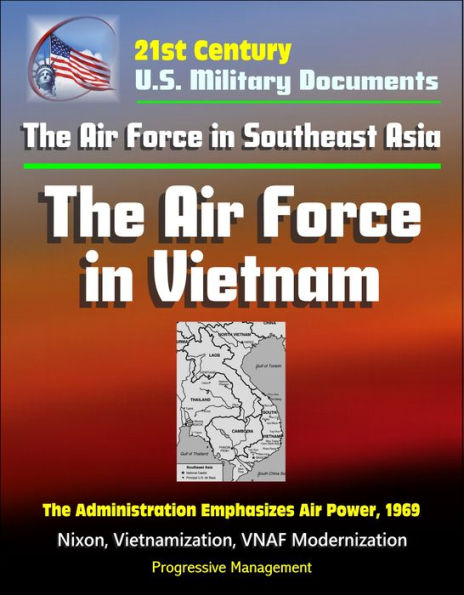In this report the author has focused on policy changes introduced by the Nixon administration during 1969 in regard to the Vietnamese war, particularly as they affected the role of air power. Repeatedly expressing determination to end the war as early as possible on the basis of self-determination of the South Vietnamese people, President Nixon decided - after negotiations with the Communists in Paris proved fruitless - to unilaterally withdraw U.S. forces while simultaneously strengthening Saigon's forces to take up the slack.
The first reduction in U.S. military strength in South Vietnam took place during the summer of 1969 when 25,000 troops were withdrawn. However, a particular phenomenon of the year was that air power was not materially reduced. The main theme of this history is that, in his effort to "wind down" the war via Vietnamization while maintaining pressure on North Vietnam to negotiate, the President made new and greater use of the U.S. air arm.
I. THE WAR IN VIETNAM UNDER A NEW ADMINISTRATION * President Nixon Reviews Policy * A Divergence of Views * II. THE DEBATE OVER AIR POWER * Views of the Lame Duck Administration * The Air Debate Under the New Administration * The Air Force Position * The JCS Position and the Arc Light Sortie Issue * The NSSM 36 Debate * III. AIR POWER IN SUPPORT OF U.S. POLICY IN SOUTHEAST ASIA * Interdiction Out-of-Country * Interdiction In-Country * Close Air Support for Ground Forces * B-52 Support Ground Forces * Innovations and Effectiveness Measures * Equipment * Night Operations * Air Power Supports Guerrilla Warfare * IV. VIETNAMIZATION: PRIORITY POLICY * The Nixon Vietnamization Plan * Change in Mission Statement * V. THE VNAF IMPROVEMENT AND MODERNIZATION PROGRAM * Phase II Planning * Equipment * Training * VNAF Operations * Facilities and Materiel * Phase III I&M * U.S. Air Power and Vietnamization * Summary
In this report the author has focused on policy changes introduced by the Nixon administration during 1969 in regard to the Vietnamese war, particularly as they affected the role of air power. Repeatedly expressing determination to end the war as early as possible on the basis of self-determination of the South Vietnamese people, President Nixon decided - after negotiations with the Communists in Paris proved fruitless - to unilaterally withdraw U.S. forces while simultaneously strengthening Saigon's forces to take up the slack.
The first reduction in U.S. military strength in South Vietnam took place during the summer of 1969 when 25,000 troops were withdrawn. However, a particular phenomenon of the year was that air power was not materially reduced. The main theme of this history is that, in his effort to "wind down" the war via Vietnamization while maintaining pressure on North Vietnam to negotiate, the President made new and greater use of the U.S. air arm.
I. THE WAR IN VIETNAM UNDER A NEW ADMINISTRATION * President Nixon Reviews Policy * A Divergence of Views * II. THE DEBATE OVER AIR POWER * Views of the Lame Duck Administration * The Air Debate Under the New Administration * The Air Force Position * The JCS Position and the Arc Light Sortie Issue * The NSSM 36 Debate * III. AIR POWER IN SUPPORT OF U.S. POLICY IN SOUTHEAST ASIA * Interdiction Out-of-Country * Interdiction In-Country * Close Air Support for Ground Forces * B-52 Support Ground Forces * Innovations and Effectiveness Measures * Equipment * Night Operations * Air Power Supports Guerrilla Warfare * IV. VIETNAMIZATION: PRIORITY POLICY * The Nixon Vietnamization Plan * Change in Mission Statement * V. THE VNAF IMPROVEMENT AND MODERNIZATION PROGRAM * Phase II Planning * Equipment * Training * VNAF Operations * Facilities and Materiel * Phase III I&M * U.S. Air Power and Vietnamization * Summary

21st Century U.S. Military Documents: The Air Force in Southeast Asia: The Air Force in Vietnam - The Administration Emphasizes Air Power, 1969 - Nixon, Vietnamization, VNAF Modernization

21st Century U.S. Military Documents: The Air Force in Southeast Asia: The Air Force in Vietnam - The Administration Emphasizes Air Power, 1969 - Nixon, Vietnamization, VNAF Modernization

Product Details
| BN ID: | 2940045448987 |
|---|---|
| Publisher: | Progressive Management |
| Publication date: | 11/13/2013 |
| Sold by: | Smashwords |
| Format: | eBook |
| File size: | 254 KB |
